Model for Crowdsourced Parcel Delivery Embedded into Mobility as a Service Based on Autonomous Electric Vehicles
Abstract
1. Introduction
- What is this combined service and how it works?
- What information system and functions are proposed?
- What information management processes are elaborated for operation?
- Why this service benefit to energy management?
2. Literature Review
3. Service Concept
- Fresh products contain but not limited at: (hot) food/drink; material for cooking: vegetables, fruit, seafood, meat, etc.; significant document or letter; gift sending purpose: flowers, etc.; medicine, supermarket/grocery ordering, etc.
- General small sized parcel considering vehicle capacity, delivery requirement is within half or one day. Products in category A are also appropriate if no instant time limitation.
- Ud: deliverer. The users of vehicle sharing service, who accept the parcel delivery task on their travel route.
- Ur: receiver. The users of parcel delivery service, who accept the embedded delivery.
- M: MaaS operator. AV fleet operator is proposed to execute this role. The major task of M is service management and fleet operation.
- D: delivery service operator. Operate the traditional delivery service. The demand of crowdsourced delivery is shared and interoperated with M.
- P: parking lot operator.
- C: charging station operator.
- Vehicle with tasks: a. embedded service, b. only passenger transport, c. only parcel delivery,
- Charging, (and parking),
- Parking in short time to wait for very next task assignment,
- Return with empty run.
4. Information System Architecture
- −
- AV: autonomous vehicle (driverless).
5. Functional Model
6. Matching Condition and Estimated Energy Saving per Delivery
6.1. Matching Condition
6.2. Energy Consumption Calculation of Scenarios
- Base data input, e.g., ffc/100, eT/W, gT/W.
- Generate random distance for L1, L2, L3. Range of each is from 1 to 10 km.
- Calculate fuel consumption of cases in each scenario.
- Convert to standardized fuel consumption and CO2 equivalents.
- Calculate the ratio (percentage) and mode values.
- Record results in percentage.
7. Discussion and Conclusions
- Deliverers have to touch parcels.
- In ‘share-a-taxi’ model, the taxi driver has to handle both the passenger and parcel. The passenger can refuse to deliver parcel.
- Parcel security is enhanced by the separated cabin.
- The joint of two services: one service user is another service server.
- Driver related problems are eliminated. Except waiting time window, the journey of passenger transit is not interrupted.
- An information system is proposed to track the delivery process.
- The concept of service,
- The information system architecture model,
- The functional model,
- The matching conditions and energy consumption calculation per parcel delivery.
Author Contributions
Funding
Institutional Review Board Statement
Informed Consent Statement
Data Availability Statement
Acknowledgments
Conflicts of Interest
References
- Zijlstra, T.; Durand, A.; Hoogendoorn-Lanser, S.; Harms, L. Early adopters of Mobility-as-a-Service in the Netherlands. Transp. Policy 2020, 97, 197–209. [Google Scholar] [CrossRef]
- Chang, S.J.; Chen, H.-Y.; Chen, H.-C. Mobility as a service policy planning, deployments and trials in Taiwan. IATSS Res. 2019, 43, 210–218. [Google Scholar] [CrossRef]
- Fatnassi, E.; Chaouachi, J.; Klibi, W. Planning and operating a shared goods and passengers on-demand rapid transit system for sustainable city-logistics. Transp. Res. Part B Methodol. 2015, 81, 440–460. [Google Scholar] [CrossRef]
- Mourad, A.; Puchinger, J.; Van Woensel, T. Integrating autonomous delivery service into a passenger transportation system. Int. J. Prod. Res. 2021, 59, 2116–2139. [Google Scholar] [CrossRef]
- Csonka, B.; Havas, M.; Csiszár, C.; Földes, D. Operational Methods for Charging of Electric Vehicles. Period. Polytech. Transp. Eng. 2020, 48, 369–376. [Google Scholar] [CrossRef]
- De Almeida Correia, G.H.; van Arem, B. Solving the User Optimum Privately Owned Automated Vehicles Assignment Problem (UO-POAVAP): A model to explore the impacts of self-driving vehicles on urban mobility. Transp. Res. Part B Methodol. 2016, 87, 64–88. [Google Scholar] [CrossRef]
- Akeb, H.; Moncef, B.; Durand, B. Building a collaborative solution in dense urban city settings to enhance parcel delivery: An effective crowd model in Paris. Transp. Res. Part E Logist. Transp. Rev. 2018, 119, 223–233. [Google Scholar] [CrossRef]
- Wang, Y.; Lei, L.; Zhang, D.; Lee, L.H. Towards delivery-as-a-service: Effective neighborhood search strategies for integrated delivery optimization of E-commerce and static O2O parcels. Transp. Res. Part B Methodol. 2020, 139, 38–63. [Google Scholar] [CrossRef]
- Alnaggar, A.; Gzara, F.; Bookbinder, J.H. Crowdsourced delivery: A review of platforms and academic literature. Omega 2019, 102139. [Google Scholar] [CrossRef]
- Guo, X.; Jaramillo, Y.J.L.; Bloemhof-Ruwaard, J.; Claassen, G. On integrating crowdsourced delivery in last-mile logistics: A simulation study to quantify its feasibility. J. Clean. Prod. 2019, 241, 118365. [Google Scholar] [CrossRef]
- Vij, A.; Ryan, S.; Sampson, S.; Harris, S. Consumer preferences for Mobility-as-a-Service (MaaS) in Australia. Transp. Res. Part C Emerg. Technol. 2020, 117, 102699. [Google Scholar] [CrossRef]
- Arias-Molinares, D.; García-Palomares, J.C. The Ws of MaaS: Understanding mobility as a service from a literature review. IATSS Res. 2020. [Google Scholar] [CrossRef]
- Arias-Molinares, D.; Palomares-García, J.C. Shared mobility development as key for prompting Mobility as a Service (MaaS) in urban areas: The case of Madrid. Case Stud. Transp. Policy 2020. [Google Scholar] [CrossRef]
- Liljamo, T.; Liimatainen, H.; Pöllänen, M.; Utriainen, R. People’s current mobility costs and willingness to pay for Mobility as a Service offerings. Transp. Res. Part A Policy Pract. 2020, 136, 99–119. [Google Scholar] [CrossRef]
- Casadó, R.G.; Golightly, D.; Laing, K.; Palacin, R.; Todd, L. Children, young people and mobility as a service: Opportunities and barriers for future mobility. Transp. Res. Interdiscip. Perspect. 2020, 100107. [Google Scholar] [CrossRef]
- Alyavina, E.; Nikitas, A.; Njoya, E.T. Mobility as a service and sustainable travel behaviour: A thematic analysis study. Transp. Res. Part F Traffic Psychol. Behav. 2020, 73, 362–381. [Google Scholar] [CrossRef]
- Xu, M.; Meng, Q.; Liu, Z. Electric vehicle fleet size and trip pricing for one-way carsharing services considering vehicle relocation and personnel assignment. Transp. Res. Part B Methodol. 2018, 111, 60–82. [Google Scholar] [CrossRef]
- Sun, X.; Li, Z.; Wang, X.; Li, C. Technology development of electric vehicles: A review. Energies 2020, 13, 90. [Google Scholar] [CrossRef]
- Un-Noor, F.; Padmanaban, S.; Mihet-Popa, L.; Mollah, M.N.; Hossain, E. A comprehensive study of key electric vehicle (EV) components, technologies, challenges, impacts, and future direction of development. Energies 2017, 10, 1217. [Google Scholar] [CrossRef]
- Darabi, Z.; Ferdowsi, M. Impact of plug-in hybrid electric vehicles on electricity demand profile. In Smart Power Grids 2011; Springer: Berlin/Heidelberg, Germany, 2012; pp. 319–349. [Google Scholar] [CrossRef]
- Bohnes, F.A.; Gregg, J.S.; Laurent, A. Environmental impacts of future urban deployment of electric vehicles: Assessment framework and case study of Copenhagen for 2016–2030. Environ. Sci. Technol. 2017, 51, 13995–14005. [Google Scholar] [CrossRef]
- Illgen, S.; Höck, M. Literature review of the vehicle relocation problem in one-way car sharing networks. Transp. Res. Part B Methodol. 2019, 120, 193–204. [Google Scholar] [CrossRef]
- Mounce, R.; Nelson, J.D. On the potential for one-way electric vehicle car-sharing in future mobility systems. Transp. Res. Part A Policy Pract. 2019, 120, 17–30. [Google Scholar] [CrossRef]
- Soltész, P.; Zilahy, G. A Network Theory Approach to the Sharing Economy. Period. Polytech. Soc. Manag. Sci. 2017. [Google Scholar] [CrossRef]
- Bálint, D.; Trócsányi, A. New ways of mobility: The birth of ridesharing. A case study from Hungary. Hung. Geogr. Bull. 2016, 65, 391–405. [Google Scholar] [CrossRef]
- Bian, Z.; Liu, X. Mechanism design for first-mile ridesharing based on personalized requirements part I: Theoretical analysis in generalized scenarios. Transp. Res. Part B Methodol. 2019, 120, 147–171. [Google Scholar] [CrossRef]
- Fernando, C.; Soo, V.K.; Doolan, M. Life Cycle Assessment for Servitization: A Case Study on Current Mobility Services. Procedia Manuf. 2020, 43, 72–79. [Google Scholar] [CrossRef]
- McKenzie, G. Urban mobility in the sharing economy: A spatiotemporal comparison of shared mobility services. Comput. Environ. Urban Syst. 2020, 79, 101418. [Google Scholar] [CrossRef]
- Kafle, N.; Zou, B.; Lin, J. Design and modeling of a crowdsource-enabled system for urban parcel relay and delivery. Transp. Res. Part B Methodol. 2017, 99, 62–82. [Google Scholar] [CrossRef]
- Kang, Y.; Lee, S.; Do Chung, B. Learning-based logistics planning and scheduling for crowdsourced parcel delivery. Comput. Ind. Eng. 2019, 132, 271–279. [Google Scholar] [CrossRef]
- Szabó, Z.; Török, Á. Spatial Econometrics–Usage in Transportation Sciences: A Review Article. Period. Polytech. Transp. Eng. 2020, 48, 143–149. [Google Scholar] [CrossRef]
- Török, Á.; Fedorko, G.; Molnar, V.; Husaková, N.; Csiszár, C. How to choose and when to start best ITS projects that enhance logistic performance? Period. Polytech. Transp. Eng. 2017, 45, 8–11. [Google Scholar] [CrossRef]
- Perboli, G.; Rosano, M. Parcel delivery in urban areas: Opportunities and threats for the mix of traditional and green business models. Transp. Res. Part C Emerg. Technol. 2019, 99, 19–36. [Google Scholar] [CrossRef]
- Schwerdfeger, S.; Boysen, N. Optimizing the changing locations of mobile parcel lockers in last-mile distribution. Eur. J. Oper. Res. 2020. [Google Scholar] [CrossRef]
- Viu-Roig, M.; Alvarez-Palau, E.J. The Impact of E-Commerce-Related Last-Mile Logistics on Cities: A Systematic Literature Review. Sustainability 2020, 12, 6492. [Google Scholar] [CrossRef]
- Yildiz, B.; Savelsbergh, M. Service and capacity planning in crowd-sourced delivery. Transp. Res. Part C Emerg. Technol. 2019, 100, 177–199. [Google Scholar] [CrossRef]
- Chen, C.-L.; Lin, D.-P.; Chen, H.-C.; Deng, Y.-Y.; Lee, C.-F. Design of a Logistics System with Privacy and Lightweight Verification. Energies 2019, 12, 3061. [Google Scholar] [CrossRef]
- Csiszár, C.; Földes, D. System model for autonomous road freight transportation. Promet Traffic Transp. 2018, 30, 93–103. [Google Scholar] [CrossRef]
- The Summarized Electronic Document ‘Calculating GHG Emissions for Freight Forwarding and Logistics Services’. Available online: https://www.clecat.org/media/CLECAT_Guide_on_Calculating_GHG_emissions_for_freight_forwarding_and_logistics_services.pdf (accessed on 12 December 2020).
- Hu, G.; Li, J.; Tang, R. The revealed preference theory of stable matchings with one-sided preferences. Games Econ. Behav. 2020, 124, 305–318. [Google Scholar] [CrossRef]
- Zhang, Z.; Kou, X.; Palomares, I.; Yu, W.; Gao, J. Stable two-sided matching decision making with incomplete fuzzy preference relations: A disappointment theory based approach. Appl. Soft Comput. 2019, 84, 105730. [Google Scholar] [CrossRef]
- Fuel Consumption Guide. 2020. Available online: https://www.nrcan.gc.ca/sites/nrcan/files/oee/pdf/transportation/tools/fuelratings/2020%20Fuel%20Consumption%20Guide.pdf (accessed on 20 December 2020).
- He, H.; Bandivadekar, A. Passenger Car Fuel-Efficiency, 2020–2025 Comparing Stringency and Technology Feasibility of the Chinese and US Standards; A Working Paper; The International Council on Clean Transportation: Francisco, CA, USA, 2013. [Google Scholar]
- Stolaroff, J.K.; Samaras, C.; O’Neill, E.R.; Lubers, A.; Mitchell, A.S.; Ceperley, D. Energy use and life cycle greenhouse gas emissions of drones for commercial package delivery. Nat. Commun. 2018, 9, 409. [Google Scholar] [CrossRef]
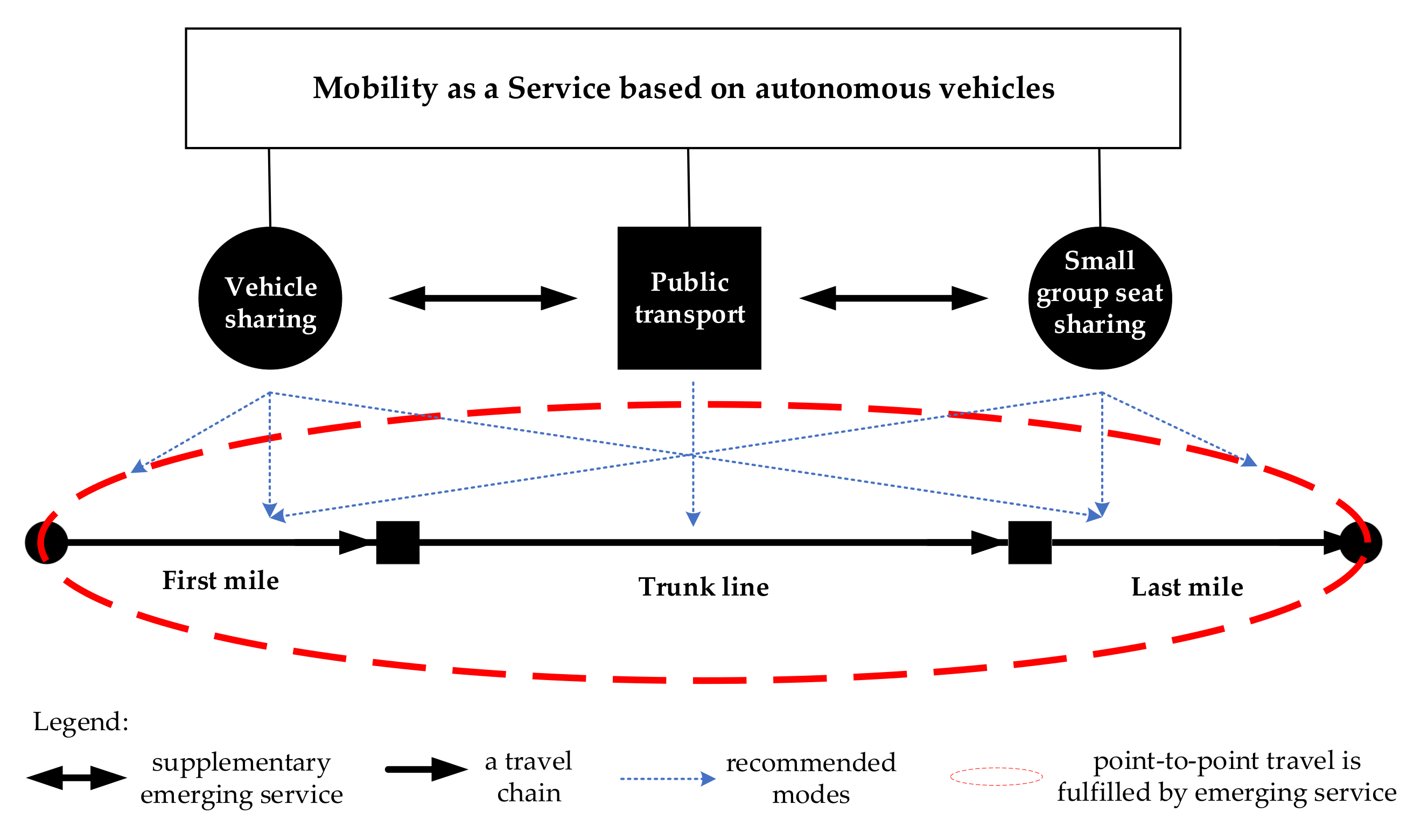

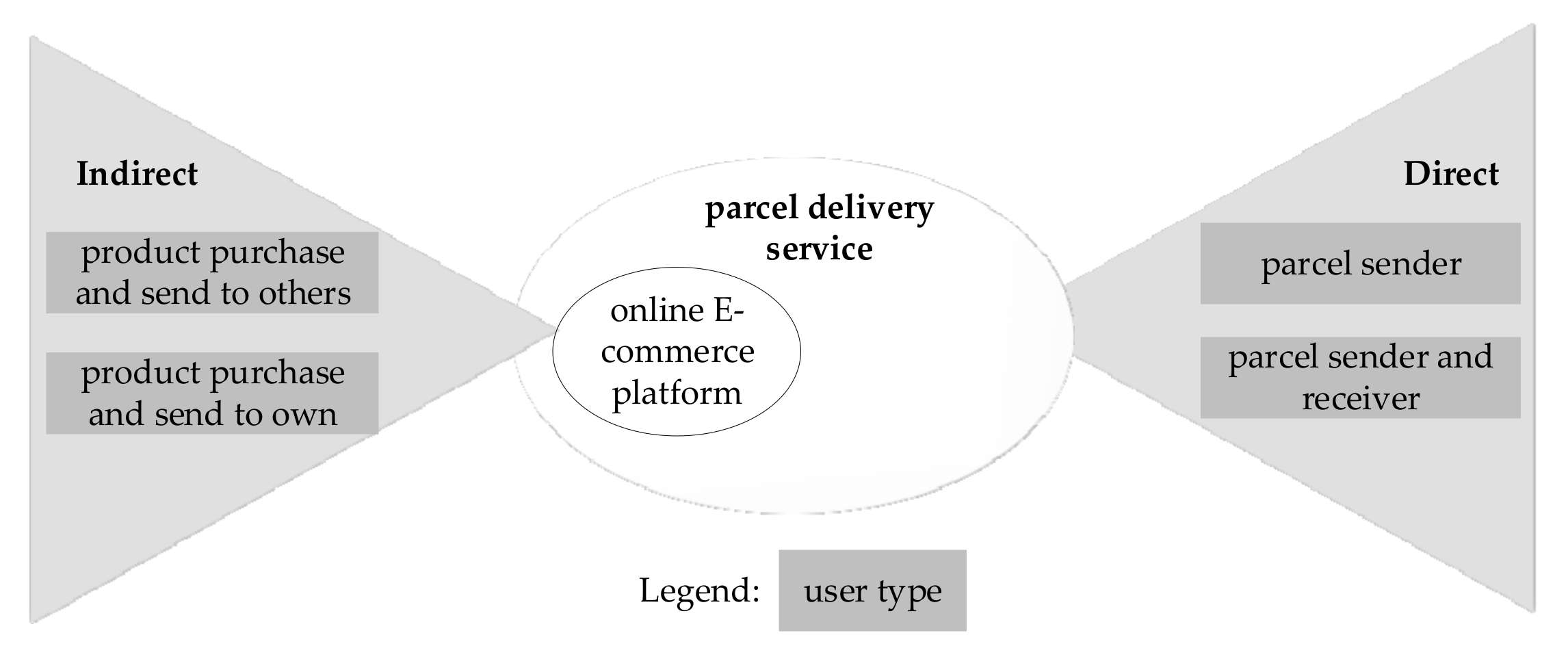




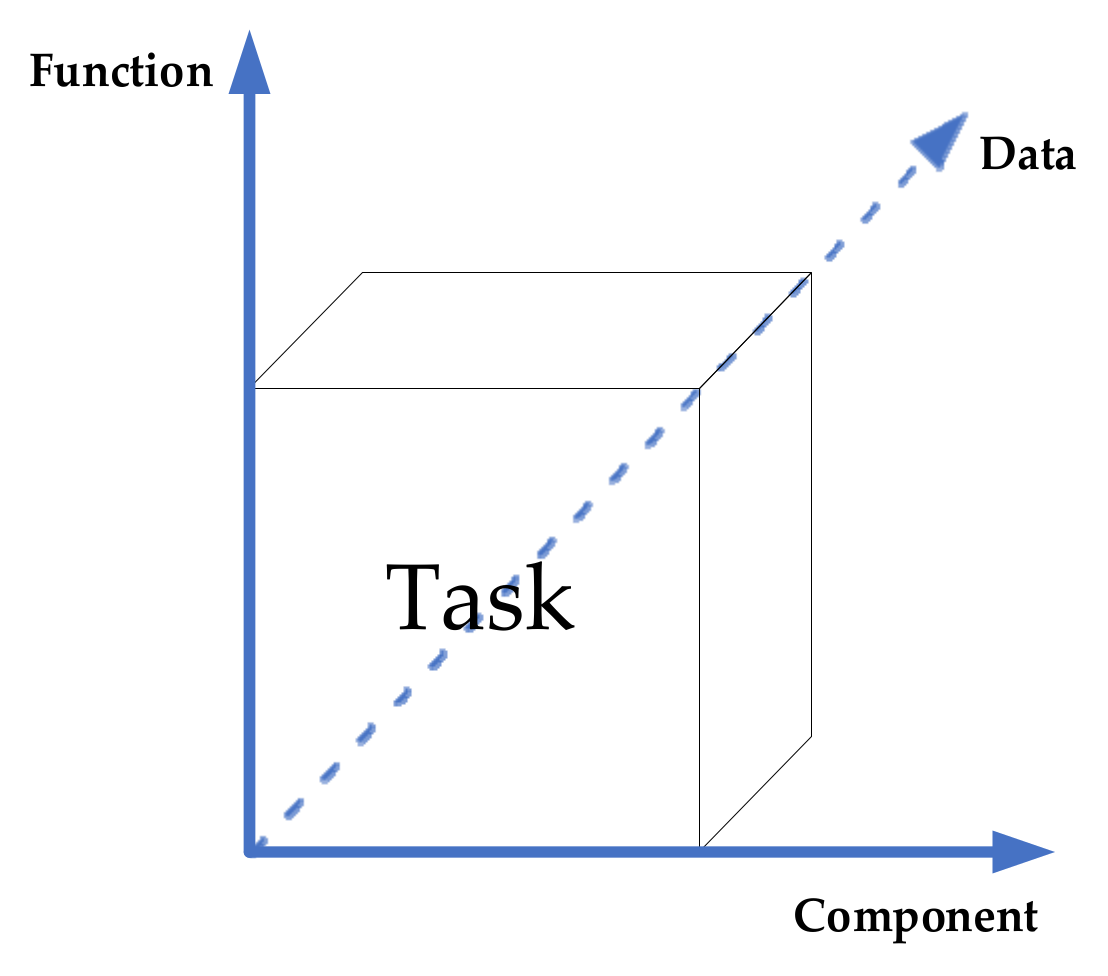



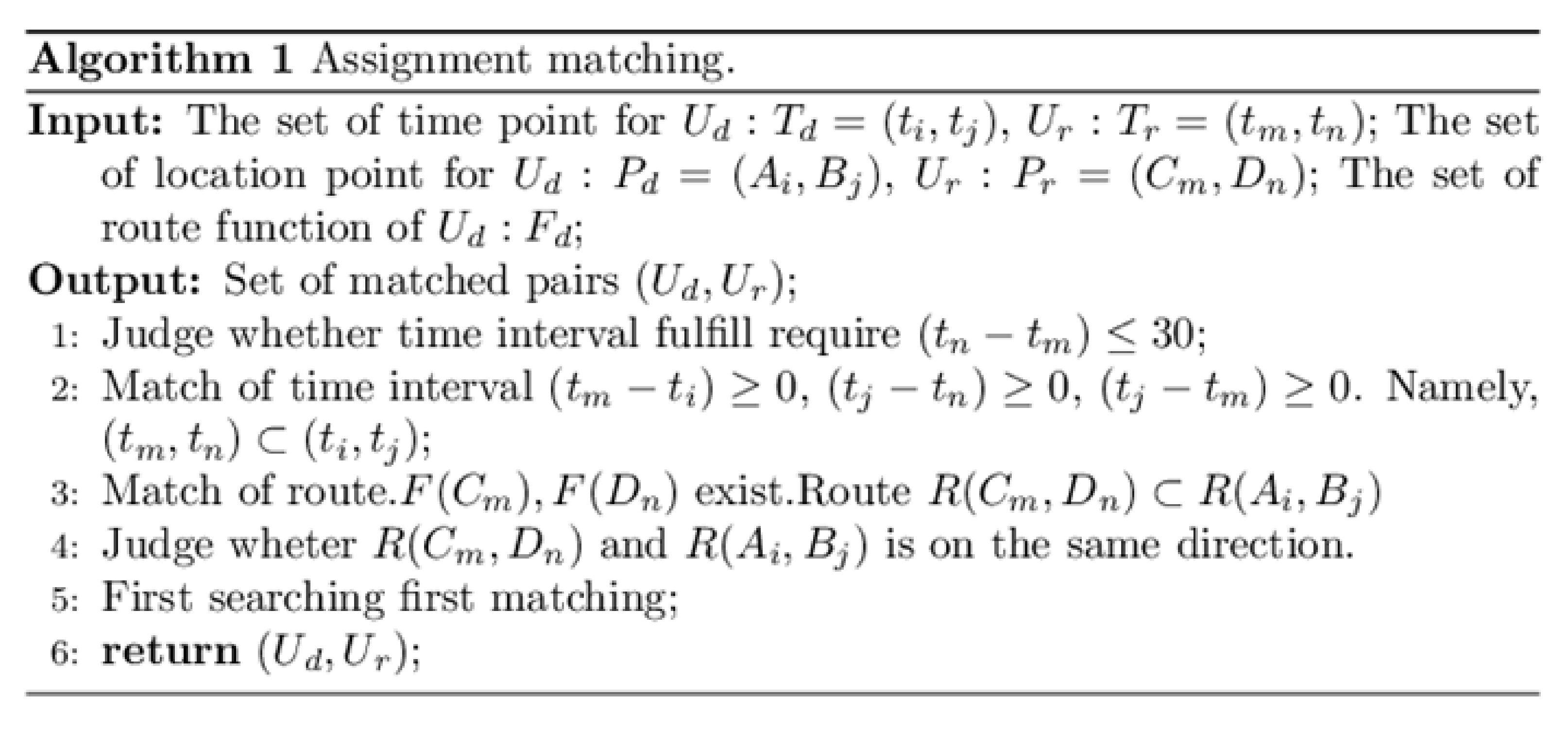
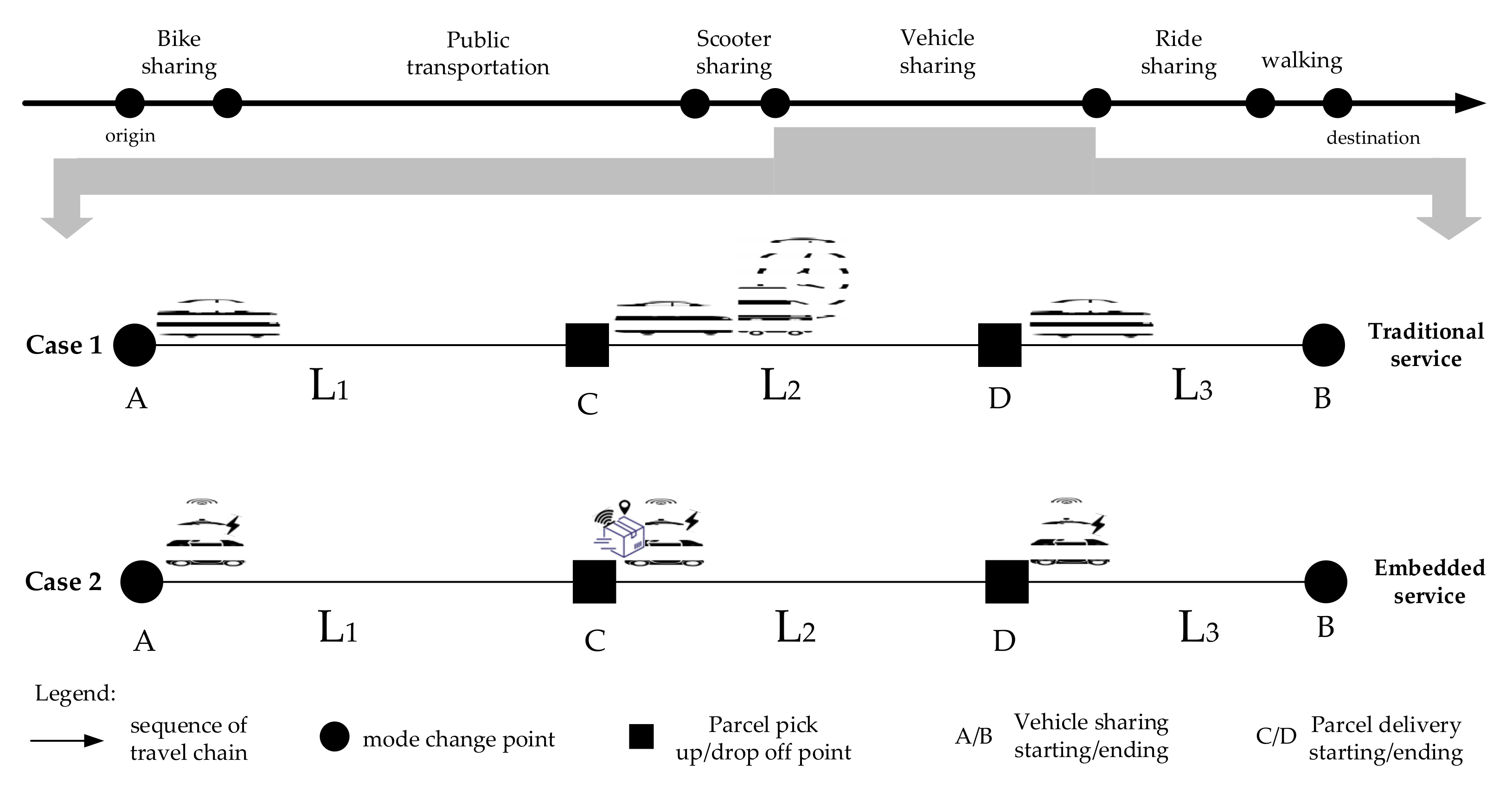

| Defined Problem | Methodology | Focus | |
|---|---|---|---|
| [3] | Movement of passengers and goods are mixed on the same network. | Mathematical modelling, simulation, (periodic–optimization approach) | Planning and operating a shared PRT–FRT (personal–freight rapid transit) mode in shared networks |
| [4] | To use the underused assets in people-based systems to transport goods, stochastic optimization problem. | Approximation method, neighborhood search algorithm | The optimization problem has been formulated as a pickup and delivery problem with time windows, with scheduled lines and stochastic passenger demand. |
| [7] | Neighborhood delivery | Simulation, delivery and population density data, circle packing | The crowd to collect and deliver parcels using neighbors |
| [8] | Delivery-as-a-service, scheduling of Online-to-Offline parcels | Mixed-integer programming, hybrid neighborhood search strategy (tabu search) | Paired pickup and delivery problem with time window, pickup-first–delivery-second |
| [9] | A review of available platforms and literatures | Method of classification and comparison | The current practices and literatures are summarized |
| [10] | A grocery model with delivery time window limitation | Simulation method, case study | To illustrate the potential advantages of proposed concept by comparing results of scenarios |
| [29] | Truck routes and schedule, simultaneous pickup and delivery problem | A mixed integer non-linear program, a tabu search based algorithm | Cyclists and pedestrians are as crowdsources who are willing to deliver parcels with truck carriers |
| [30] | A realistic crowdsourced parcel delivery problem | Function approximation, artificial neural network, liner programming | Maximize profitability to manage orders and improve efficiency |
| Aspects | Vehicle Sharing | Small Group Seat Sharing |
|---|---|---|
| Vehicle size | small | medium |
| Capacity limit | individual, maximum 2 | 2–6 |
| Separated parcel cabin | yes | no |
| Embedded delivery service | yes | no |
| Priority | embedded delivery | passenger transit |
| Only parcel delivery (compensate empty run) | peak-off + redistribution | peak off + redistribution |
| Affect passenger transit | yes | no |
| Walking distance to access vehicle | no | yes |
| Triangle Cooperation in Tasks: Information Process | |||
|---|---|---|---|
| Ud–D–M | Offered delivery opportunity | D–M–AV | Delivery vehicle management |
| M–AV–Ur | Receiver–vehicle match | AV–Ur–Ud | Users–vehicle match |
| Ur–Ud–D | Service request match | Ud–D–AV | Deliverer–vehicle notification |
| D–M–Ur | Delivery request response | M–AV–Ud | Deliverer–vehicle match |
| AV–Ur–D | Receiver–vehicle notification | Ur–Ud–M | Service match and notification |
| Quadrilateral Cooperation in Tasks: Physical Process | |||
| Ud–D–M–AV | Deliverer carries parcel on | D–M–AV–Ur | Receiver picks parcel off |
| M–AV–Ur–Ud | Pick off confirmation to M | AV–Ur–Ud–D | Pick off confirmation to D |
| Ur–Ud–D–M | Parcel service ending | Ur–Ud–D–M–AV | Ideal system optimum circulation |
| F1. Demand Announcement | F2. Vehicle Checking 1 | F3. Assignment | F4. Booking |
| F5. Routing | F6. Vehicle checking 2 | F7. Identification | F8. Monitoring |
| F9. Feedback handling | F10. Payment | F11. Redistribution | F12. Maintenance |
| Data Group | Static Data (s) | Semi-Dynamic Data (sd) | Dynamic Data (d) |
|---|---|---|---|
| User (U): Deliverer (Ud), Receiver (Ur) | account data customization setting | service data preferences payment feedback | position (GPS) identification current reservation |
| Vehicle (V) | base data of vehicle battery capacity | service data maintenance | state of charge position (GPS) identification |
| Charging station (C) | data of charging point data of charging station | point reservation maintenance | current reservation |
| Parking lot (P) | data of parking space data of parking lot | space reservation maintenance | current reservation |
| Network (N) | nodes, lines, interchange, etc. vehicles geographic, topology data of route | route recommendation | GPS of vehicle traffic signal route situation traffic, delay, congestion |
| MaaS operator (M) | fleet data (e.g. number of vehicles, vehicle type, condition) historical records maintenance data | service coordination schedule of public transport reservation payment split and transfer service package | current coordination price data redistribution estimated time payment state feedback handling |
| Parcel delivery operator (O) | base data of parcels (e.g. size, goods type, time limitation) | service data feedback | assignment GPS of parcel identification |
| Meaning | Unit | |
|---|---|---|
| Fec | Energy consumption | L or kwh |
| ffc/100km | Fuel consumption per hundred kilometer | L/100 km or kwh/100 km |
| L | Travel distance: length of route | km |
| T | TTW, tank-to-wheel. Direct consumption and emission from vehicle operation. | |
| W | WTW, well-to-wheel. Consumption from energy generation and vehicle operation. | |
| ET/W | Standardized energy consumption (tank-to-wheel or well-to-wheel) | MJ |
| GT/W | CO2 equivalence (tank-to-wheel or well-to-wheel) | kg |
| eT/W | Covert factor of standardized energy consumption | MJ/L or MJ/kwh |
| gT/W | Covert factor of CO2 equivalence | kg/L or kg/kwh |
| wi | Weight of parcel i | kg |
| W | Weight of vehicle | t or kg |
| n | Number of parcels delivered per delivery | |
| cv | Conventional vehicle (petrol or diesel powered) | |
| Ed | Electric delivery vehicle (small size) | |
| AEV/EV | Electric vehicles or autonomous electric vehicles | |
| Fuel Type | Standardized Energy Consumption | CO2 Equivalents | ||
|---|---|---|---|---|
| eT | eW | gT | gW | |
| MJ/L | kg (CO2e)/L | |||
| Petrol | 32.2 | 37.7 | 2.42 | 2.88 |
| Diesel | 35.9 | 42.7 | 2.67 | 3.24 |
| MJ/kwh | kg (CO2e)/kwh | |||
| Electricity (c) | 3.6 | 10.2 | 0 | 0.424 |
| Type | Weight | Fuel Consumption | Petrol | Diesel | Electricity |
|---|---|---|---|---|---|
| conventional vehicle (cv) | 1.5 t | L/100 km | 6 | 4.5 | |
| AEV/EV | 1.2 t | kwh/100 km | 16 | ||
| Electric delivery vehicle (Ed) | 0.35 t | kwh/100 km | 3.3 |
| Scenario 1 | ||||||||||
|---|---|---|---|---|---|---|---|---|---|---|
| Fuel | eT (MJ) | Sum | gT (kg) (CO2e) | Sum | eW (MJ) | Sum | gW (kg) (CO2e) | Sum | ||
| Case 1 | cv | petrol | 46.368 | 46.962 | 3.485 | 3.485 | 54.288 | 55.971 | 4.147 | 4.399 |
| diesel | 38.772 | 39.366 | 2.884 | 2.884 | 46.116 | 47.799 | 3.499 | 3.751 | ||
| Ed | electricity | 0.594 | - | 0 | 0 | 1.683 | - | 0.252 | - | |
| Case 2 | AEV | electricity | 13.824 | 13.824 | 0 | 0 | 39.168 | 39.168 | 1.628 | 1.628 |
| Scenario 2 | ||||||||||
| Case 1 | EV | electricity | 13.824 | 14.418 | 0 | 0 | 39.168 | 40.851 | 1.628 | 1.880 |
| Ed | electricity | 0.594 | - | 0 | 0 | 1.683 | - | 0.252 | - | |
| Case 2 | AEV | electricity | 13.824 | 13.824 | 0 | 0 | 39.168 | 39.168 | 1.628 | 1.628 |
| Per Parcel Delivery | Energy Saving (MJ) | CO2e Decrease (kg) | |||
|---|---|---|---|---|---|
| Compared Fuel | eT | eW | gT | gW | |
| Scenario 1: case 1 compare with case 2 | petrol and electricity | 33.138 | 16.803 | 3.485 | 2.771 |
| diesel and electricity | 25.542 | 8.631 | 2.884 | 2.123 | |
| Scenario 2: case 1 compare with case 2 | electricity | 0.594 | 1.683 | 0 | 0.252 |
| Scenario 1 case 1 compare with Scenario 2 case 1 | petrol and electricity | 32.544 | 15.12 | 3.485 | 2.519 |
| diesel and electricity | 24.948 | 6.948 | 2.884 | 1.871 | |
Publisher’s Note: MDPI stays neutral with regard to jurisdictional claims in published maps and institutional affiliations. |
© 2021 by the authors. Licensee MDPI, Basel, Switzerland. This article is an open access article distributed under the terms and conditions of the Creative Commons Attribution (CC BY) license (https://creativecommons.org/licenses/by/4.0/).
Share and Cite
He, Y.; Csiszár, C. Model for Crowdsourced Parcel Delivery Embedded into Mobility as a Service Based on Autonomous Electric Vehicles. Energies 2021, 14, 3042. https://doi.org/10.3390/en14113042
He Y, Csiszár C. Model for Crowdsourced Parcel Delivery Embedded into Mobility as a Service Based on Autonomous Electric Vehicles. Energies. 2021; 14(11):3042. https://doi.org/10.3390/en14113042
Chicago/Turabian StyleHe, Yinying, and Csaba Csiszár. 2021. "Model for Crowdsourced Parcel Delivery Embedded into Mobility as a Service Based on Autonomous Electric Vehicles" Energies 14, no. 11: 3042. https://doi.org/10.3390/en14113042
APA StyleHe, Y., & Csiszár, C. (2021). Model for Crowdsourced Parcel Delivery Embedded into Mobility as a Service Based on Autonomous Electric Vehicles. Energies, 14(11), 3042. https://doi.org/10.3390/en14113042







